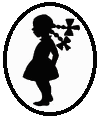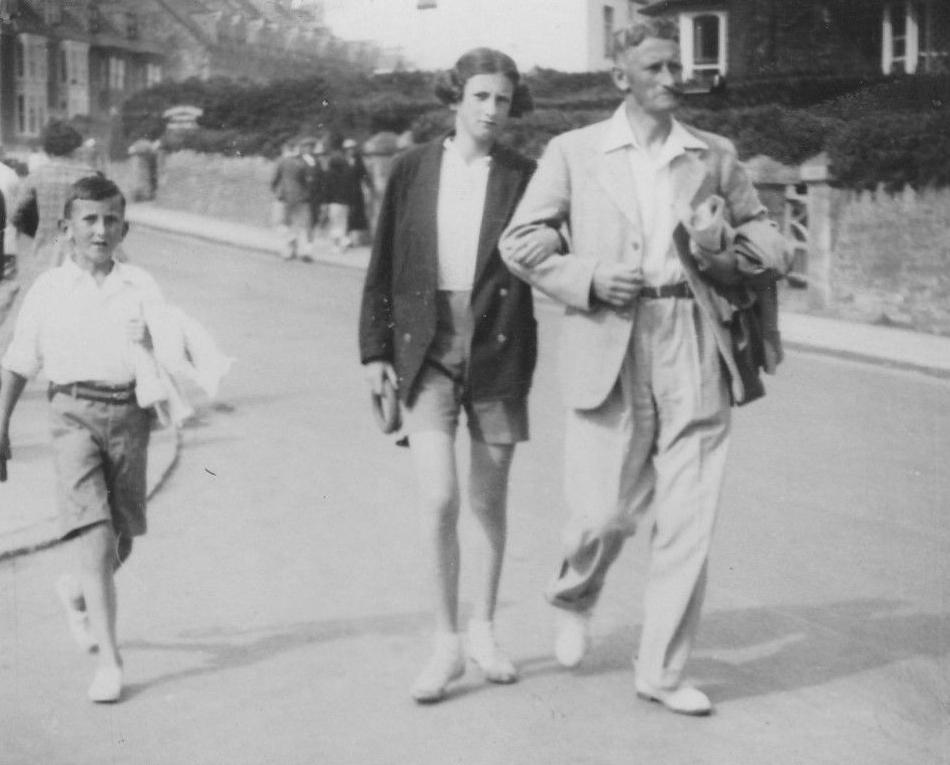

Historical English Girls' Clothing: Pants

Figure 1.--This photograph shows a family headed to the beach on their summer holiday, we think about 1930. We think the girl attended a boarding school and may have wore short pants for school gymnastics. Images like this were not very common, but it shows that English girls by the 30s were wearing short pants in play are casual occassions. We are not sure how common it was, but it clearly was not exceptional. Notice her little brothers snake belt and white sneakers without socks.
|
|
Pants were a garment that men and boys after breeching exclusively wore since they first appeared in the West (17th century). The first exception was pantalettes (19th century), although girls wore them exclusively as an under garment. At the turn of the 20th century we still do not see girls wearing pants, including shorts. Even for school gym, girls mostly wore bloomer or romper pants rather than shorts. We see women wearing pants during the War, mostly young women in work factory settings or the Woman's Land Army. This did not begin to change for girls until after World War I in the 1920s. And even then we rarely see girls wearing pants. The only exception was school gym where we do begin to see girls beginning to change from bloomers to shorts. This continued to be unusual for some time. We see some young women wearing long trousers as a fashionable style (1930s). The frugality of World War II and the stress on practicality undoubtedly had an impact. It does not seem to have affected girls wear greatly, but after the War we do begin to see some girls wearing pants, mostly shorts. The overall trend toward casual wear was a another factor. We begin to see girls wearing short and long pants, although the time line was a little slower than in America. The popularity of jeans was another factor. The shorts that we do see are wearing them for casual play occassions, usually during the summer. Girls did not wear shorts to school until the late-20th century, and then only in primary school. School with uniforms insisted in dresses or skirts.
Chronology
Pants were a garment that men and boys after breeching exclusively wore since they first appeared in the West (17th century). This was no small matter. Women were burned at the stake for dressing like men--it was associted with witchcraft. Men's trousers in the 18th century were knee breeches. Women and girls did not wear them. We do not yet have photograohy to conform thid, but paintings and drawings clearly show girls andwomen only wearing skirts and dresses. The first exception was pantalettes (19th century), although girls wore them exclusively as an under garment. We don't see anyone wearing Amelia Bloomer's blomers, ar least in the 19th century photographic record. At the turn of the 20th century we still do not see girls wearing pants, including shorts. The Girl Guides unlike the Boy Scouts did not make fashion breakthroughs. Even for school gym, girls mostly wore bloomer or romper pants rather than shorts. This did not begin to any extent change until after World War I in the 1920s. And even then we rarely see girls wearing pants. The only exception was school gym where we do begin to see girls beginning to change from bloomers to shorts. This continued to be unusual for some time. We see some young women wearing long trousers as a fashionable style (1930s). And we begin to see girls wearing shorts for casual occassions, but not to school like the boys. We see women wearing pants during the War, mostly in work settings. It does not seem to have affected girls wear greatly, but after the War we do begin to see some girls wearing pants, mostly shorts. The frugality of World War II and the stress on practicality undoubtedly had an impact. The overall trend toward casual wear was a another factor. We begin to see girls wearing short and long pants, although the time line was a little slower than in America. The popularity of jeans was another factor. The shorts that we do see are girls wearing them for casual play occassions, usually during the summer. Girls did not wear shorts to school until the late-20th century, and then only in primary school. School with uniforms insisted in dresses or skirts.
Girls mostly wore skirted garments with few exceptions through the 19th cerntury, but in the 20th century wesee some girls wearing various types of pants. The primary expetion was pantalettes. Pantalettes were basically an undergarment, but for many yearsandunder garment made to be seen. Both boys and girls wore them. They began to be seen as Empire-style long dresses began to go out of style (1830s) and boys began wearing shortened-length pants (1850s). Pantalettes were avery common garment. Bloomers appeared in the mid-19th century, but we don't see Englidh girls and women wearing them to any extent. There was one exception. Both public education and girls education expanded in England during the 19th century, especially the late-19th century. And girls in secondary scgool wore bloomers as part of gym classes. Romper suits appearedin the 20th century. Unlike Francewhere rompers were a boys' garment, girls wore rompers in England. American girls wore rompers suits as part of gym uniforms. Weare not sure about England. Knee breches wre the standardform of trousers worn by men and boys in the 18th century. Women and girls did not wear them. You also do not see girls wearing pants in the 19th century. Boy began wearing long pants with the skeleton suits that were popular at the onset of the 19th century. Shortened-length trousers appeared for boys (mid-19th century). We see both bloomer knickers, regulsr knickers, and knee pants. Girls did not wear any of these garments in the 19th century. This did not begin to change until the 20th century, mostly after World War I in the 1920s. You do not see girls wearing long pants, even in the winter. But you do behgin to see girls wearing short pants, primrily for play or casual wear. At school girls continued to weardressesor skirts, but by tghe endof the century you see some girls at non-uniform primary schools wearing shorts.
Age Trends
Occasions
HGC

Navigate the Boys' Historical Clothing Web Site:
[Return to the Main English girls garment page]
[Return to the Main English girls page]
[Return to the Main girls country page]
[Return to the Main girls page]
[About Us]
[Activities]
[Biographies]
[Chronology]
[Color]
[Countries]
[Difficult images] >> combine w/ photo interprtation
[Fashion]
[Families]
[Garments]
[Gender conventions]
[Hair]
[Literature]
[Photo intrpretation]
[School]
[Sisters]
[Return to the Historical Girls Clothing Home Site]
Created: 4:02 AM 8/7/2018
Last updated: 11:58 AM 1/30/2019




